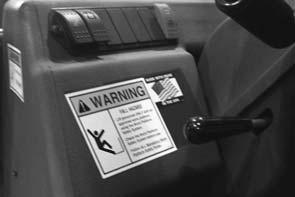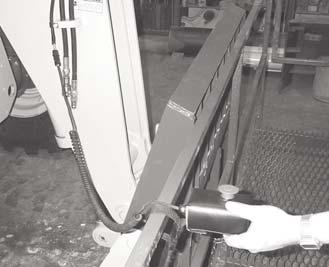
7 minute read
PERSONNELWORK PLATFORM SAFETYSYSTEM
SAFETY
ALWAYS look in the direction of travel. Look to the rear before backing. ALWAYS use the recommended handholds and steps with at least three points of support when getting on and off the machine. Keep steps and platform clean. Face the machine when climbing up and down. DO NOT raise or drop a loaded fork or bucket suddenly. Abrupt movements under load can cause serious instability. Study the load charts carefully. They show maximum capacity to be lifted and placed at specific outward and upward distances. ALWAYS be aware of load weights prior to attempting lift and placement. DO NOT exceed the machine’s rated operating capacity for the type of attachment tool being used. DO NOT allow minors or any unqualified personnel to operate or be near the machine unless properly supervised. DO NOT start the engine or operate any controls unless properly seated in the operator’s seat! DO NOT run the engine in an enclosed area without providing proper ventilation for the exhaust.
Exhaust gases contain carbon monoxide, an odorless and deadly gas. Internal combustion engines deplete the oxygen supply within enclosed spaces and may create a serious hazard unless the oxygen is replaced. This includes the atmosphere within the cab when provided. DO NOT leave the operator’s station with the boom and attachment tool raised. ALWAYS lower the boom and attachment tool to the ground, shut off the engine and engage the park brake BEFORE leaving the operator’s station. DO NOT drive too close to an excavation or ditch.
BE SURE that the surrounding ground has adequate strength to support the weight of the machine and the load it is carrying. DO NOT turn quickly while traveling on a slope or operate the machine beyond the grade and slope limits noted in the Operation and Adjustments chapter of this Operator’s Manual. NEVER allow riders on this machine. This is strictly a single-seat, NO passenger machine! NEVER use as a lift for personnel unless the machine is equipped with the Personnel Work
Platform (PWP) Safety System. When road travel is required, know and use the signaling devices on the machine. Provide an escort and Slow-Moving Vehicle (SMV) emblem when required. If necessary to park on a grade, park across the slope and block the tires.
Servicing Safety Reminders
ALWAYS be aware of and avoid pinch point areas on the machine, such as wheels-to-frame, cylinders-to-frame, and boom-attachment-tool-toframe. NEVER attempt to by-pass the keyswitch to start the engine. ONLY use the jump-starting procedure detailed in the Service and Storage chapter. NEVER use your hands to search for hydraulic fluid leaks. Instead use a piece of paper or cardboard. Escaping fluid under pressure can be invisible and can penetrate the skin, causing serious injury. If any fluid is injected into your skin, see a doctor at once. Injected fluid MUST be surgically removed by a doctor familiar with this type of injury or gangrene may result. ALWAYS wear safety glasses with side shields when striking metal against metal. In addition, it is also recommended that a softer (chip-resistant) material be used to cushion the blow. Failure to heed could lead to serious injury to the eyes or other parts of the body. DO NOT refill the fuel tank when the engine is hot. Allow engine to cool down BEFORE refilling to prevent the hot engine from igniting the fuel if it should spill or splash. DO NOT smoke while filling the fuel tank, while working on the fuel or hydraulic systems, or while working around the battery. DO NOT fill the fuel tank completely. Allow room for expansion. Maintain control of the fuel filler
SAFETY
nozzle when filling the tank. Use the correct fuel grade for the operating season. NEVER use fuel for cleaning purposes. DO NOT remove the radiator cap after the engine has reached operating temperature or if it is overheated. At operating temperatures, the engine coolant will be extremely hot and under pressure.
ALWAYS wait for the engine to cool down before attempting to relieve pressure and remove the radiator cap. Failure to heed this warning could result in severe burns. DO NOT loosen or disconnect any hydraulic lines, hoses or fittings without first relieving hydraulic circuit pressure. Also, be careful not to touch any hydraulic components that have been in recent operation, because they can be extremely hot and can burn you! Avoid lubrication or mechanical adjustments with the machine in motion or the engine operating. If the engine must be in operation to make certain adjustments, place the transmission in neutral, apply the park brake, place the equipment in a safe position, securely block the tires and use extreme caution. To ensure continued safe operation, replace damaged or worn-out parts with genuine Manitou N.A. service parts BEFORE using this equipment.
Modifications and additions that affect capacity or safe operation shall not be performed without the manufacturer’s prior written approval. Where such authorization is granted, any applicable markings are to be changed accordingly. All attachment tools MUST be marked to identify the attachment tool and the total capacity with attachment tool at maximum elevation with the load laterally centered. ALWAYS be sure all nameplates, caution and instruction markings are in place and legible.
Local government regulations may require specific decals, which then become the responsibility of
the owner or user to provide.
Safety Guards and Warning Devices
This machine is fitted with a Roll-Over Protective
Structure (ROPS) and Falling Object Protective
Structure (FOPS) in accordance with industry standards. It is intended to offer protection to the operator from falling objects, and in case of an overturn, but it cannot protect against every possible hazard. Therefore it should not be considered a substitute for good judgment and safe practices in operating the machine. If the ROPS/FOPS structure is damaged, it must be replaced to restore the protection it provides. This machine is equipped with a horn and backup alarm. The user must determine if operating conditions require that the machine be equipped with additional devices (mirrors, rotating beacon, etc.) and be responsible for providing and maintaining such devices.
Personnel Work Platform (PWP) System
WARNING
The machine must not be used to lift or carry personnel, or be fitted with any form of personnel work platform unless fitted with the optional PWP System. If fitted with the PWP System, the Mandatory Work Platform Safety Rules must be followed at all times while lifting personnel.
The Mandatory Work Platform Safety Rules must be followed to at all times while lifting personnel. These rules are based on ANSI/ITSDF Standard B56.6-2005, “Safety Standard for Rough Terrain Forklift Trucks.” (A copy of this and related standards can be obtained from the Industrial Truck Standards Development Foundation, 1750 K Street NW, Suite 460, Washington DC 20009; or downloaded from: www.itsdf.org.) The rules apply to the owner, operator and personnel in the work platform.
SAFETY
MANDATORY WORK PLATFORM SAFETY RULES
1.The work platform must comply with
ANSI/ITSDF Standard B56.6-2005, Sec. 8.24,
“Platforms for Elevating Personnel.” (See page 15, “Work Platform Design Requirements.”) 2.The platform must be securely attached to the carriage or forks, and the carriage securely attached to the boom. 3.The carriage and forks must be secured to prevent them from pivoting upward. 4.If the machine is equipped with a rotating or swinging carriage, the rotation or swing must be deactivated. (This occurs automatically when the
“PWP System” is switched on.) 5.Personnel on the platform must be provided protection from any moving parts on the forklift that may present a hazard. 6.If overhead hazards exist for platform personnel, overhead protection must be provided. 7.Be sure that the lifting mechanism is operating smoothly throughout its entire range, both empty and loaded, and that any lift-limiting devices and latches are functional. 8.Be sure that the frame is level, to ensure a vertical lift. 9.Be sure the platform is horizontal before lifting. 10.Be sure that the forklift has a firm footing. 11.Be sure that any required restraining means (railings, chains, harnesses, etc.) are in place and properly used. 12.Before lifting personnel, shift the transmission into Neutral, apply the parking brake, and activate the “PWP System” switch. 13.Before lifting personnel, the area should be marked to warn others of work by elevated personnel. 14.Be sure the path of platform travel is clear of hazards, such as scaffolds, electrical wires and overhead obstructions.
WARNING
Use ONLY an approved work platform for elevating personnel.
NEVER move the machine with the work platform in a raised position or with personnel on board.
NEVER tilt the platform forward, rearward, or to the side with personnel aboard.
ALWAYS engage the PWP System and follow the Mandatory Work Platform Safety Rules when lifting personnel.
Work Platform System Switch
Electrical Connection
PWP Remote Shutdown Switch

Remote Shutdown Switch With Coiled Wire








